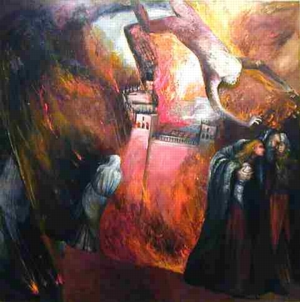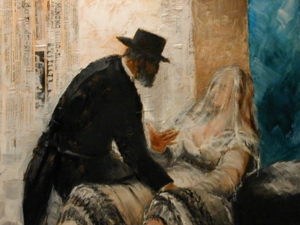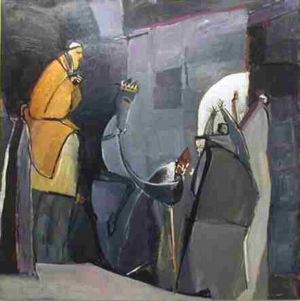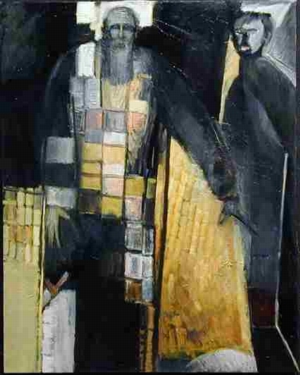In his new collection, The Family Diamond, Edward Schwarzschild, author of the novel Responsible Men asks if being good is the same as doing the right thing. After all, a person with good intentions, a relatively clear conscience, strong personal values, faith in his or her family or partner, and some sense of stability and belonging can still experience and even engender misconceptions, devastation, disloyalty, and doubt.
 Through dramatized situations and internal reactions, Schwarzschild suggests that it might take more than doing the "right" thing to be honest and faithful to oneself and one’s life – and that blindly and methodically adhering to one’s perceived responsibilities without understanding how they change can alienate the people and situations one meant to uphold.
Through dramatized situations and internal reactions, Schwarzschild suggests that it might take more than doing the "right" thing to be honest and faithful to oneself and one’s life – and that blindly and methodically adhering to one’s perceived responsibilities without understanding how they change can alienate the people and situations one meant to uphold.
A fourth-generation Philadelphian, Edward Schwarzschild had gone to college to become a doctor. But after he became interested in literature and writing as a pre-med student, and in order not to stray too much from his course to doctorhood, Schwarzschild initially sacrificed pursuing an MFA in Creative Writing to earn a PhD in American Literature, focusing on the tradition of combined photography and prose in American literature before James Agee’s and Walker Evans’s seminal Let Us Now Praise Famous Men. He accepted a post teaching American Literature, and upon arriving at Sweet Briar College, a small liberal arts college in Amherst, Virginia, asked to start a Film Studies – and they not only let him, they also sent him to Hardvard for further study during the summers.
“I found studying silent and sound film fascinating and also inspiring, especially when it came to learning more ways to tell stories,” he says of his fortuitous post in film. But he also became aware of the danger of heedlessly pursuing literary success:
Unfortunately, I also found that many writers who traveled to Hollywood in the 30s and 40s were ultimately destroyed in one way or another. In general, those who survived and even thrived there refused, like Faulkner, to actually live there. There were, of course, special cases, like Budd Schulberg, who was from a powerful Hollywood family and was also able to write a gripping, revealing novel about Hollywood. But Fitzgerald’s story, Agee’s story – they were tragedies.
Hollywood may control most of American film production, but it doesn’t own the medium or its  relation to fiction writing, and Schwarzschild is a good example of this: “Working on screenplays taught me a lot about scene-based writing,” says Schwarzschild, whose prose is plain and straightforward, full of imaginative detail, still maintaining intimacy with the reader. His tone is familiar yet literary, bordering on vernacular but always conscious of its storytelling role, as characters’ internal reflection most often deals directly either with the subject or the circumstances of their story, rarely digressing beyond the scope of the narrative. Their understanding is confined to their current experience, their projected future, and the past that relates to both. "I’m drawn to characters who are in a plight," Schwarzschild explains. “Characters who have not yet achieved what they were ‘supposed to,’ who want to be better, but who don’t know where they went wrong, don’t know what to do to be better."
relation to fiction writing, and Schwarzschild is a good example of this: “Working on screenplays taught me a lot about scene-based writing,” says Schwarzschild, whose prose is plain and straightforward, full of imaginative detail, still maintaining intimacy with the reader. His tone is familiar yet literary, bordering on vernacular but always conscious of its storytelling role, as characters’ internal reflection most often deals directly either with the subject or the circumstances of their story, rarely digressing beyond the scope of the narrative. Their understanding is confined to their current experience, their projected future, and the past that relates to both. "I’m drawn to characters who are in a plight," Schwarzschild explains. “Characters who have not yet achieved what they were ‘supposed to,’ who want to be better, but who don’t know where they went wrong, don’t know what to do to be better."
Making the Work Connect Schwarzschild grew up in a Reform environment, aware of being Jewish in a home that was hardly kosher; but through references to Jewish stories, he associates himself with the tradition of Jewish tales. "A constellation of influences affects my work while I am writing,” he says. The figure of a one-winged angel, for example, which appears in several seemingly unrelated stories, came from several sources: an image by Paul Klee, Marquez’s man with wings, and the notion propounded by Ba’al Shem Tov that every misguided thought wounds an angel. Rabbi Nachman’s tale of the world’s heart that yearns for the geyser across the void, which a character hears in synagogue, first reached Schwarzschild through the play Dybbuk. Mildred Diamond, the book’s proclaimed matriarch, goes blind toward the end of her life, and in a reference that seems to point to the 13th century kabbalist Isaac the Blind, mystically regains her sight. "It’s a question of reinterpretation, citation, of making the work connect,” Schwarzschild says. "I want it to be a part of, to be steeped in, the writers that brought me to writing: Grace Paley, James Agee, Roth, Salinger, Miller, Tillie Olsen, Isaac Babel, and many others."
Of the motivations in the process of writing The Family Diamond, Schwarzschild says:
Writing a collection of stories is similar to writing a novel in that there’s so much discovery along the way. The collection started with a desire to write some stories around Milly and Charlie Diamond. I wanted to look at different facets of their older kind of relationship. I also wanted to juxtapose their relationship with their metaphorical and/or actual descendants’ attempts to create families. And I found myself very much interested in both the failures and successes of those descendants.
Because the book’s perspective almost invariably includes childhood and youth, it documents a series of failures, unfulfilled promises, and deceptive high hopes. Whereas the oldest generation is situated closer to Judaism – as children, they are taken synagogue and told about the meaning of Yom Kippur – the youngest generation is trying to create a path through American society and values. Yet lacking  experience, these characters fall for their hopes as a gateway into overly serious circumstances entailing relationships and child-conception, as if none of them has a grasp on reality until he or she has been tricked into it. "I feel empathy for many of these characters because their road will not be easy,” he says. “They have a desire for success in life, but no path to follow. They haven’t achieved what they were ‘supposed to’ partly because they followed false dreams, got lost, and don’t know where to turn next." Schwarzschild locates his stories on the thin border between naively stepping into situations that constitute real responsibility, and dealing with those situations to take initiative and determine one’s own path.
experience, these characters fall for their hopes as a gateway into overly serious circumstances entailing relationships and child-conception, as if none of them has a grasp on reality until he or she has been tricked into it. "I feel empathy for many of these characters because their road will not be easy,” he says. “They have a desire for success in life, but no path to follow. They haven’t achieved what they were ‘supposed to’ partly because they followed false dreams, got lost, and don’t know where to turn next." Schwarzschild locates his stories on the thin border between naively stepping into situations that constitute real responsibility, and dealing with those situations to take initiative and determine one’s own path.
The Family Diamond focuses intently on the institution of a nuclear family, and the character that emerges most in varying stages and facets is that of a mother who fails to embody a maternal role and maintain it. In "Proposals and Advice," Charlie Diamond, one of a few recurring characters, recounts how his grandson’s mother (that is, his daughter), who had been beside herself when proposed to, finally leaves her husband, gives her one-year-old child to her parents, and moves to California. In "What to Expect," a young man who had lost his mother at a young age enters a relationship with a slightly older woman, who finds his lonely and over-enthusiastic father difficult to bear; she too becomes pregnant, and though the story ends when her water breaks, one can only imagine that she’ll stick to that son and his father for a year or two before, like some of the other women in the book, leaving them behind.
Family Ties This is all part of a near-obsession of the younger characters over the notion of having a family, what a family can be, how to perpetuate an existing family, and sometimes how to let a family fall apart. "Something was lost in the kind of relationship the older generation had, and nothing has come in to replace what was let go. We’ve lost something, too, and the solution isn’t simply to go back and duplicate exactly what came before us.”
With some reserve, Schwarzschild speaks of change that is mindful of its history, of becoming more religiously observant than his parents, for his own sake and that of the next generation:
We have to do our best to understand what we’ve lost and then build something new based on that knowledge, something new that fits our current situation. But not everyone these days is willing – for all sorts of reasons – to make the compromises that building a family necessarily requires, to take on the responsibilities of being matriarchs and patriarchs.
Indeed, there are characters who prevent the "wrong" family from forming, either by terminating an early pregnancy or refusing to marry the man who was sure he’d become a fiancé. And there are those so disturbed by their childhoods, such as the alienated (literally) younger brother in "Distance Man," that they never reached the point of considering a family. The only people who don’t seem to have made any mistakes, or who have been pardoned for those they made, are those who have died. The others wallow in a conciliatory limbo.
The magical couple Mildred and Charlie Diamond – who after living a full and loving life with each other, bringing up first their daughter and then their grandson, literally regain their youth – are the center-piece of the book, embodying an all-encompassing humor and compassion that comes from  security in one’s own primary relationship. Historically, their marriage is located at the middle-point between immigration and attempted assimilation, in a time that looked less to the past or the future than to preserving the present, which they had to invent at each step. "They’re the characters closest to ‘real life,’ the least imaginary, especially Milly,” Schwarzschild explains. "They grew up in kosher households, spoke Yiddish. But after getting married, their focus shifted to the standard immigrant concern: something better for the children – bigger house, education, comfort – and working toward that, some things of the past got left out." They do everything they can for their family and their friends and yet one gets the sense that what really keeps them alive is each other. This middle-stage, as well as their security in each other, partly precludes them from the experience of their parents’ daily struggle or their children’s and grandchildren’s attempts to enter American society at large.
security in one’s own primary relationship. Historically, their marriage is located at the middle-point between immigration and attempted assimilation, in a time that looked less to the past or the future than to preserving the present, which they had to invent at each step. "They’re the characters closest to ‘real life,’ the least imaginary, especially Milly,” Schwarzschild explains. "They grew up in kosher households, spoke Yiddish. But after getting married, their focus shifted to the standard immigrant concern: something better for the children – bigger house, education, comfort – and working toward that, some things of the past got left out." They do everything they can for their family and their friends and yet one gets the sense that what really keeps them alive is each other. This middle-stage, as well as their security in each other, partly precludes them from the experience of their parents’ daily struggle or their children’s and grandchildren’s attempts to enter American society at large.
Thinking of his dejected grandson, whose girlfriend had unexpectedly turned down her hand in marriage, Charlie Diamond says, "Remember it all…Someday you’ll want all those memories." And Schwarzschild adds, "Even painful memories you want; when you lose something, you keep what you can." But one gets the sense that Charlie Diamond would not relate to his own experience with such a yearning rooted in failure or unrealized hope, for his love of his wife and her love of him are nearly sublime. This is a non-judging nostalgia for the past, with which one is disappointed and nonetheless reconciled, suggesting that any past is valuable for having been lived.
And though the characters’ thoughts and emotions can border on the nostalgic or precious, by describing so many facets and circumstances under which families form and fall, Schwarzschild acknowledges that justifying one’s life this way is in part a shirking of responsibility. Never discounting those without a satisfying past on which to look back, he also suggests that it is possible to take steps to influence that past now, directing it into something to look back upon fondly.
Images by Richard McBee. From top:Genesis, Judah, Esther, and Abraham and Isaac.








What your declaring is totally accurate. I know that everybody need to say the exact same issue, but I just believe that you set it in a way that every person can understand. I also appreciate the photos you put in right here. They suit so effectively with what youre trying to say. Im guaranteed youll achieve so many men and women with what youve acquired to say.
I was reading through some of your content on this internet site and I believe this site is really instructive! Keep putting up.
Youre so cool! I dont suppose Ive read anything such as this prior to. So nice to uncover somebody with many original ideas on this subject. realy thanks for starting this up. this fabulous website can be something that is required on the internet, somebody with a little originality. valuable problem for bringing something totally new on the web!
I am frequently to blogging and i also truly appreciate your content regularly. The article has really peaks my interest. I will bookmark your website and keep checking choosing details.